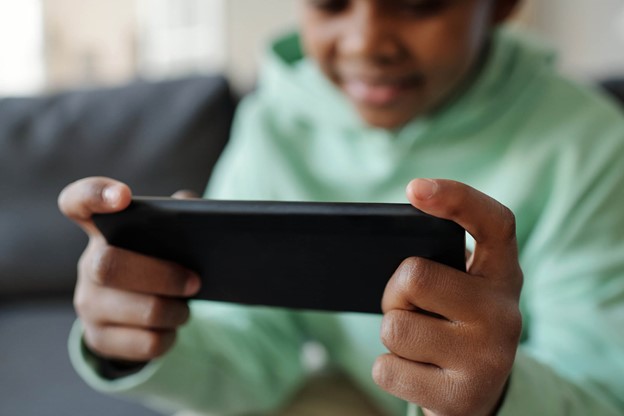Screen Time in the Digital Age: Establishing Healthy Habits for Children
Establishing Healthy Screen Time Habits for Kids
At Lionheart, we’re parents, too. Like you, we’re all concerned about how screen usage can impact our children’s social, physical, and mental development. TVs, computers, iPads, and smartphones are more pervasive than ever, and parents often straddle the line between convenience, social pressure, and child happiness. Technology is an invaluable tool for learning and stimulation for children, yet overexposure can create challenges for children as they mature. Knowing how to manage your children’s screen time responsibly can be difficult for parents and children alike. Discover how technology can be used for the betterment of your children while preventing the negative impacts associated with overuse.

Understanding Screen Time Guidelines for Kids
The topic of screen time for children has been fiercely debated. So, it’s no surprise that many of the leading health organizations in the country and across the globe have recommended guidelines for screen time usage for children during different stages of development. Most pediatric professionals agree on the following:
- Under 18 Months Old – Children 18 months and younger are developing their sensory and motor skills. Introduction of screens can significantly inhibit their development as they begin to understand the world around them. Screen time should be avoided except when video chatting with friends and family.
- 18-24 Months Old – Parents can begin introducing screen time to children between the ages of 18 to 24 months. However, parents should participate in the experience as well. Co-viewing offers numerous benefits. Firstly, it ensures your child is watching age-appropriate and educational videos. Secondly, it allows you to engage with your child to help build strong social bonds.
- Two-Five Years Olds – Parents can gradually increase their child’s screen time to less than an hour. While they may spend more time using their devices, parents are encouraged to continue co-viewing media alongside their kids to help them engage with the content meaningfully.
- Six–12 Years Old – Technology is engrained in our society, but monitoring your child’s screen time by co-viewing and asking questions about the content they are exploring allows them to navigate the digital world responsibly.
These recommendations are based on the idea that children should enjoy a balance of physical, social, and cognitive activity to help stimulate their developing brains. Excessive screen time often creates less time for essential types of learning opportunities and skill-building children need as they grow. Parents, guardians, and educators are tasked with creating a strategy for helping children navigate the emergence of technology in their daily lives.
How Does Excessive Screen Time Impact Children?
Today’s parents are the first generation of parents for whom technology is used in nearly every aspect of their child’s life. Some children wake up to the sound of their Amazon Alexa or smartphone alarm. Refrigerators have screen interfaces to see what’s inside. Even schools encourage the use of laptops to make educational resources more accessible. The consequences of excessive screen time are multifaceted and can have long-lasting effects on your children:
- Physical – Extended screen use can lead to a variety of physical health issues. Numerous studies have noted a correlation between increased screen usage and obesity due to a lack of physical activity. Children who use screens often strain their eyes, contributing to blurred vision. Poor posture during device usage can lead to acute and chronic pain. The bright phone screens can also inhibit sleep cycles.
- Social – Heavy screen use can impede the development of essential interpersonal skills, including empathy, problem-solving, and communication. A lack of face-to-face interaction can make it more challenging for children to manage real-world social cues and nuances. Family bonding time can also be impacted as children are isolated in their rooms during these memory-making moments.
- Mental – Screen time has been linked to increased anxiety and depression diagnoses in children. The bombardment of fast-paced media can also reduce ability to focus and decrease attention spans, making it challenging for children to engage deeply with educational content or long-form reading.
What Strategies Can Establish Healthy Screen Time Habits?
Setting boundaries regarding screen time with your child can be challenging. Many parents are pulled in so many different directions that the idea of allowing your child to use your phone, iPad, or video game so you can get a moment of peace is enticing. However, establishing healthy boundaries isn’t about banning your child from ever using screens but creating a relationship in which your child doesn’t need a screen to be entertained. Learn more about some of the common strategies you can adopt:
- Model Behavior – Children learn best by example. By practicing moderation in personal screen use, adults reinforce the value of balance.
- Engaging Content – When your child uses a device, ensure they interact with educational and age-appropriate content. You can also extend and reinforce learning by talking with your child about what they learned.
- Time-Tracking App – Set and use screen time limits, and consider tools and apps that automate this process. Be transparent about the limits and the rationale behind them.
- Tech–Free Zones – Creating areas of the home, especially the child’s bedroom, as tech-free zones can help create healthy boundaries for your child. It also provides them with a space they aren’t enticed to be connected. Instead, they can participate in other activities.
- Consistency – Create specific timeframes for screen time, and stay consistent day after day. Routine helps provide a structure that young children are willing to follow.
- Encourage Different Activities – Children often use their phones when bored. Encouraging them to participate in after school activities, play with siblings or friends, and even help with tasks around the home – such as cooking – can help them find new passions and avoid screen time.
- Educate Your Children – Children are not unreasonable. Explaining your reasoning for limiting screen time and the negative impact of excessive use allows them to feel like they are in control of the decision-making process and encourages them to be responsible.
- Reward Non–Screen Activities – Praise and even sometimes reward your children for engaging in activities that don’t involve screens, which can reinforce positive behavior and encourage them to explore other activities.
Is All Screen Time Bad for My Child?
Most conversations regarding screen time focus on how it can negatively impact children. However, it’s essential to acknowledge that with the right guidelines and age-appropriate content, technology offers numerous benefits to children. Technology is used in homes, classrooms, libraries, and other spaces where children can learn, thrive, and grow. Discover more about how technology and screen time can be used to supplement educational experiences:
- Educational Resources – The internet puts the world’s information at our fingertips like never before. Children can use technology to research topics that are interesting to them. Technology is also used to help narrow the accessibility gap for children with unique learning abilities.
- Enhanced Learning – Technology can make learning more engaging for students. For example, apps that teach coding, language learning programs, and virtual reality experiences transport students for immersive learning.
- Social Connections – Screens allow social connections. Children with family members across the globe can instantly connect with each other wherever they live. It also allows parents and children to stay connected whenever they’re needed.
Create Screen Time Habits That Make Sense for Your Family
As technology becomes increasingly ingrained in our daily lives, parents, guardians, and educators should begin focusing on establishing healthy screen time habits for children rather than eliminating it entirely. By remaining informed, staying proactive, and developing consistent strategies, your children can enjoy technology’s numerous benefits without suffering the consequences of overexposure.
Staying engaged in your child’s screen time usage and developing a healthy dialogue about its uses and hazards can help children become responsible digital citizens. There’s no one-size-fits-all solution, but with thoughtful consideration, limits, and variety, we can ensure that technology remains a tool for growth and not a crutch that hampers development. At Lionheart Children’s Academy, we’re committed to ensuring children have the skills and experiences necessary to help them utilize technology in a responsible way. Learn more today.

